Clonal composition of hematopoietic tissue in reconstituted mice after repeated treatment with G-CSF
Irina Shipounova (Nifontova), Natalia Sats, Daria Svinareva, Tatiana Petrova, Nina Drize, Valeriy Savchenko
National Hematology Research Center, Russian Academy of Medical Science, Moscow, Russia
Accepted 13 November 2008
Published 10 December 2008
Summary
The clonal composition of hematopoietic tissue was studied in chimeras reconstituted with bone marrow cells expressing the human adenosine deaminase gene after repeated rounds of G-CSF treatment. Six courses
of G-CSF treatment led to an insignificant decrease of clone numbers and a considerable reduction in clone size and lifespan. The data suggest that the dissociation of the hematopoietic stem cells from their microenvironment after G-CSF treatment resulted in the exhaustion of clone size, and a decrease in the proliferative potential of the hematopoietic stem cells. Repeated G-CSF treatment adversely affects the hematopoietic system.
Keywords
Colony forming unit-spleen (cfu-s), retroviral gene transfer, g-csf, hematopoietic stem cells,
Introduction
The hematopoietic system is one of the most dynamic and stable systems in the organism. Hematopoiesis originates in single, pluripotent, hematopoietic stem cells (HSCs) that are capable of differentiation and self-renewal. The ability of HSCs to differentiate into all eight hematopoietic lineages has been confirmed in previous research [1], but further studies are needed to measure the upper limit of the self-renewal potential of HSCs. Prior research shows that hematopoiesis in mice reconstituted with retrovirally-marked HSC is caused by multiple mainly short-lived clones. These results were obtained by the analysis of the retroviral insertion sites of individual colonies derived from the spleen colony-forming unit (CFU-S) [2]. Polyclonal hematopoiesis was also observed in other animals [3, 4]. The developmental fate of individual, marked clones was studied during the lifespan of several animals. The results revealed that 1) hematopoiesis is mainly the product of the small clones of hematopoietic cells; 2) the lifespan of the majority of clones is only 1 to 2 months; 3) the clones usually function locally; and 4) the vast majority of the clones replace one another sequentially. Primitive HSCs, capable of producing long-lived clones that exist during the entire lifespan of a mouse (constituting approximately 10% of all clones), were detected by the radiation-marker technique [5]. Such clonal kinetics suggests the exhaustion of hematopoietic clones followed by subsequent recruiting of new clones via proliferation (clonal succession). This also suggests the ability of the HSCs to proliferate and then return to a quiescent status.
Granulocyte colony-stimulating factor (G-CSF) induces the separation of the HSCs from their stromal niches, resulting in their mobilization into the circulation of the body [6]. Repeated injections of G-CSF may induce the proliferation of clones, leading to increased exhaustion of the hematopoietic system. At the same time, mobilized HSCs that have dissociated with their niche might not return to a quiescent state efficiently. Analysis of the influence of G-CSF on the clonal composition in chimeras could validate the stability of the hematopoietic system after such treatment and clarify the mechanisms of clonal hematopoiesis.
In this study, clonal hematopoiesis was demonstrated by using mice that were reconstituted with bone marrow cells expressing the human adenosine deaminase (hADA) gene while undergoing repeated G-CSF treatment. The dosage of 25 μg/kg is considered insufficient for HSC mobilization in mice [7], although it is approximately five times greater than the dosage used for the mobilization of HSCs in humans [6].
Materials and methods
Mice
Twelve to thirty-week-old male and female CBF1 (C57Bl/6xCBA) F1 mice were used as donors and recipients, respectively. Recipient mice were exposed to 1000 cGy 137Cs irradiation divided into two sessions, each exposure three hours apart. Donor mice were injected intravenously with 5-Fluorouracil (5-FU, Sigma, USA, 150 mg/kg body weight) two days before bone marrow (BM) aspiration. For the CFU-S assay [8], irradiated female mice were injected i.v. with 1-3x105 bone marrow cells from reconstituted animals and 10-day-old spleen colonies were isolated for DNA analysis.
Transduction of hematopoietic cells with recombinant virus
Donor bone marrow cells from male mice were pre-stimulated for two days by placing the cells on the irradiated (40 Gy) stroma of three-week-old long-term bone marrow cultures, incubated at 37oC in Fisher medium (ICN, USA), and supplemented with 20% fetal calf serum (Hyclone, USA). Pre-stimulated bone marrow cells were transferred onto the irradiated (40 Gy) monolayer of PGK-hADA cells that produce a retrovirus containing the human ADA gene [9]. The bone marrow cells were incubated in the full media containing 4 μg/ml polybrene (Sigma, USA) for 48 hours, as described [2]. Immediately after, infected cells were injected into irradiated female recipients (1.2 x 106 cells/mouse) for the long-term reconstitution assay. To determine gene transfer efficiency, a small aliquot of cells was injected for CFU-S assay. Transduction efficiency was 90 % (30 CFU-S were analyzed).
Analysis of the recipient animals
Bone marrow samples were collected under light anesthesia from the femurs of individual reconstituted mice before G-CSF treatment. At the same moment the peripheral blood of each mouse was analyzed. The procedure was carried out monthly, ranging from three to eight months after transplantation [2]. In brief, bone marrow was aspirated repeatedly from the left and the right femurs alternatively by puncturing through the knee joint with a 22-gauge needle. Aliquots of bone marrow from each mouse (1-3 x 105 cells) were injected into seven irradiated female recipients for CFU-S (day 10) analysis and the rest of the bone marrow cells were used for DNA isolation. For identification of CFU-S origin, PCR analysis of Smc gene located both on X and Y chromosomes had been used:
5’- CTGAACTATTTGGATCAGATTGC-3’(exon 3) (sense) and 5’-CACCGACGGTCCTTGCAGAT-3’ (exon 4) (antisense) (Surin V.L., unpublished). By using these primers it is possible to synthesize the 391 bp fragment from the gene copy localized on the Y chromosome, and to synthesize the 429 bp fragment from the gene copy localized on the X chromosome. The difference in the fragment length reflects the difference in the intron length on different chromosomes. Thirty-two cycles of PCR were performed: denaturation 940С – 1 min, annealing 620С – 1 min, synthesis 720С – 2 min. Fragments were analyzed in a 2% agarose gel.
PCR and Southern blot analysis of CFU-S-derived colonies
DNA from total bone marrow and individual spleen colonies was extracted and the PGK-hADA provirus was detected by PCR [2]. DNA samples proven to be positive for hADA underwent the standard Southern blotting technique [10]. The samples were digested with the restriction enzyme EcoRI, then analyzed by electrophoresis using a 1% agarose gel. Subsequently, they were transferred to the Hybond N+ filter and hybridized with an hADA cDNA probe, prepared from a 418 bp fragment of hADA gene amplified by PCR [10]. Digestion with EcoRI permits analysis of individual clones, since only one EcoRI restriction site is present within the vector used. The alignment of bands was based on molecular weight standards (phage λ DNA digested with HindIII).
G-CSF treatment
G-CSF (Neupogen 48 Mio U, F.Hoffmann-La Roche) was dissolved in 0.85% NaCl solution with 0,1% bovine serum albumin (Sigma) and injected subcutaneously according to the dosage of 25 μg/kg in 0.2 ml for 4 days per course. The mice received six courses of G-CSF monthly, starting from three months after reconstitution. The last course was performed eight months after reconstitution.
The scheme of the experiments is represented in Fig. 1.
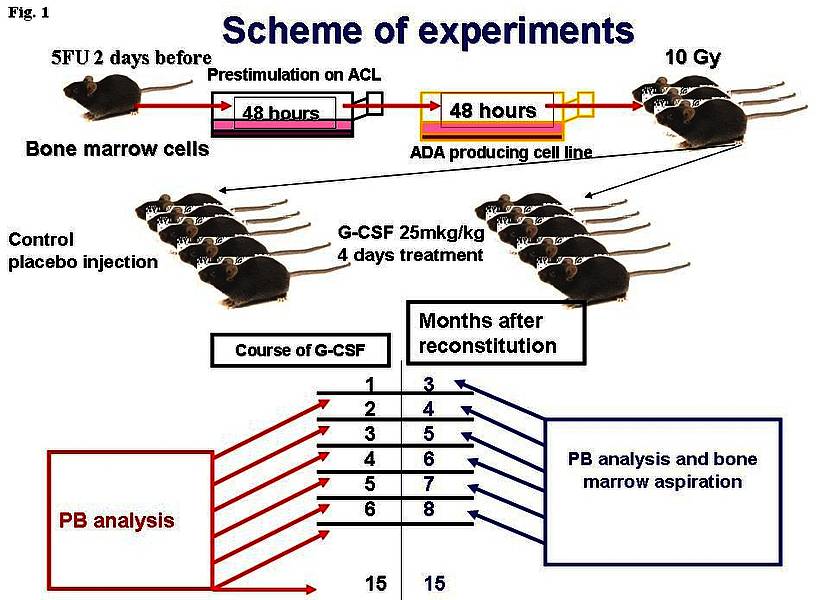
Figure 1. Methodology.
Reconstituted mice were divided into 2 groups. One group was injected with G-CSF; the control group was injected with the placebo. G-CSF was injected for 4 days in a row, once a month. Before each course of G-CSF, peripheral blood was analyzed and a bone marrow aspiration was performed. Bone marrow cells from each mouse were transplanted to secondary irradiated recipients (7 animals per reconstituted mouse) for CFU-S analysis. After the end of each G-CSF course, a peripheral blood analysis was performed. Six G-SCF rounds of injections were given altogether. The last analysis was performed 15 months after the reconstitution.
Statistics
Statistical analysis was done using Student's t-test.
Results and discussion
The number of leukocytes and the proportion of granulocytes in the peripheral blood of the reconstituted mice did not change significantly after repeated G-CSF treatment (Fig. 2 A, B). The fluctuation of leukocytes numbers was due to seasonal variations rather than constrained by G-CSF treatment; the frequency of fluctuations was the same for the animals treated with G-CSF as with the placebo animals. There was no influence of the low dose of G-CSF on the mature blood cells, thus supporting the data obtained from non-irradiated mice [11, 12].
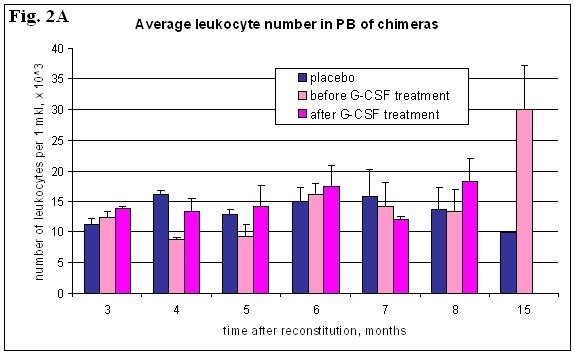
Figure 2. Peripheral blood analyses
A. Number of leukocytes in chimeras. Data are shown as the means (±SEM).
Axis of abscissa: time after reconstitution, months
Axis of ordinate: number of leukocytes per mkl of blood, х 103
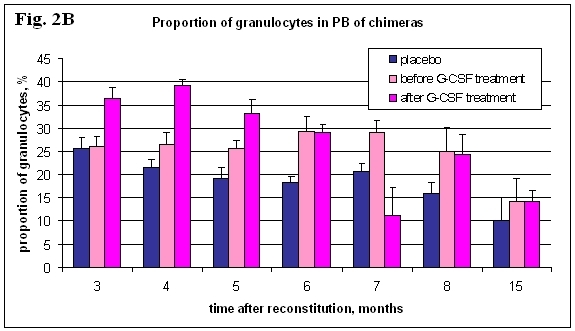
B. Proportion of granulocytes in chimeras. Data are shown as the means (±SEM).
Axis of abscissa: time after reconstituion, months
Axis of ordinate: proportion of granulocytes, %
The concentration of CFU-S in the bone marrow of the reconstituted mice did not change after G-CSF treatment (Fig. 3 A). Only once after the second course of G-CSF did the concentration of CFU-S increase in the bone marrow of treated mice. Later on such changes were not observed in the bone marrow of those animals.
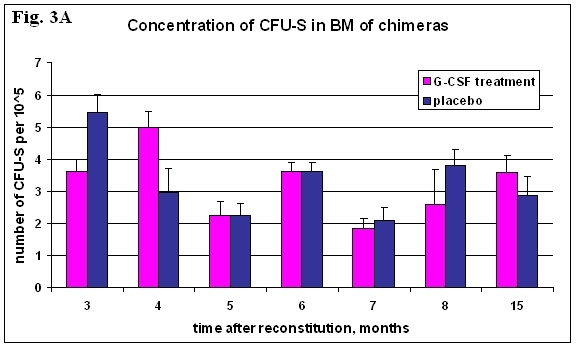
Figure 3. CFU-S in the bone marrow of chimeras
А. Concentration of CFU-S. Data are shown as the means (±SEM).
Axis of abscissa: time after reconstitution, months
Axis of ordinate: CFU-S number per 100,000 bone marrow cells
Among reconstituted mice, 100% donor chimerism is rare; a partial reversal to the hematopoiesis recipient marrow is usually observed. This occurs because of the survival of the recipients’ HSCs even after high doses of irradiation. The ratio of donor and recipient CFU-S were analyzed in the bone marrow of all experimental animals. The dynamics of the changes in donor CFU-S concentration is shown on Fig. 3 B. The proportion of donor CFU-S varied from month to month from 35 to 88%. In the group of reconstituted mice that were not treated with G-CSF, the proportion of donor CFU-S was significantly higher than in the groups that were treated (71.2±6.9% versus 56.5±5.3%, р<0.05). Such differences could be explained by the dual influence of G-CSF on hematopoiesis in chimeras. G-CSF can activate quiescent recipient HSCs that survived after irradiation. Perhaps without G-CSF stimulation such cells would have entered the cycle much later. The reversion to recipients’ hematopoiesis also increased in the old animals [13]. On the other hand, G-CSF could have induced the donor pre-stimulated early HSCs to proliferate and differentiate, thus exhausting CFU-S with their high proliferative potential.

B. Proportion of donors’ CFU-S. Data are shown as the means (±SEM).
Axis of abscissa: time after reconstitution, months.
Axis of ordinate: proportion of Y-positive CFU-S, %
Significant differences (р<0.05) were observed in the proportion of marked CFU-S in reconstituted mice (Fig. 3 С). The proportion of transdused CFU-S in the G-CSF treated group was lower and more stable than the non-treated ones (20.6±7.1% versus 45.7±6.3%). Cells were marked due to their proliferation at the moment of viral infection so they had divided at least once more than the non–marked ones, thereby diminishing their proportion two-fold. Such precursor cells could be more sensitive to G-CSF treatment and exhausted by differentiation sooner than similar cells in non-treated animals. This data suggest that G-CSF can selectively affect different hematopoietic precursor cells, changing their developmental fate and, as a consequence, inducing significant disturbance in the hematopoietic system.
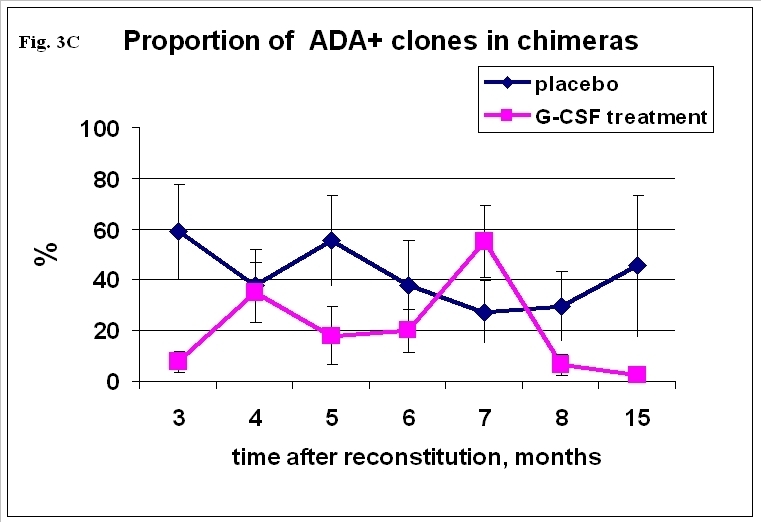
С. Proportion of genetically marked CFU-S. Data are shown as the means (±SEM).
Axis of abscissa: time after reconstitution, months
Axis of ordinate: proportion of ADA-positive CFU-S, %
Analysis of individual clones in untreated and treated animals did not reveal significant differences in their average number (Fig. 4 А). It was shown earlier that the number of clones observed depends on the frequency of analysis and the method of pre-stimulation of HSCs before marking them with the retroviral vector [2, 5, 14]. This work revealed that the clonal composition of hematopoietic tissue is not sensitive to extrinsic factors and probably depends on intrinsic regulation. The tissue is not connected with local stromal or distantly regulated by hematopoietic growth factors [15]. Thus, the hematopoietic system is one of the most stable systems in the organism and also very well protected from external actions (i.e., bleeding and other stresses).
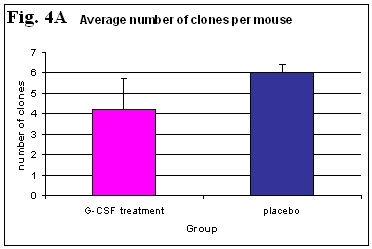
Figure 4. Clonal composition of CFU-S in chimeras
А. Average number of clones per mouse. Data are shown as the means (±SEM).
Axis of abscissa: group
Axis of ordinate: number of detected clones
However, G-CSF treatment affects the size of the clones (measured by the number of colonies representing one clone) and their longevity in the bone marrow. The size of the clones significantly decreased upon treatment, as clones were represented by fewer colonies (Fig. 4 B). The period through which those clones were detected was also noticeably shortened (Fig. 4 C). Relatively long-lived clones (detected for more than 3 months) were not observed after G-CSF treatment. Even relatively low doses of G-CSF treatment led to the disconnection of HSCs with the hematopoietic stroma [16]. It was shown previously that the dissociation of HSCs from the stromal microenvironment resulted in the very rare detection of long-living marked clones that function during the lifespan of the organism. Long-living clones were produced only in experiments not involving bone marrow transplantation – the procedure was based on the dissociation of bone marrow cells toward single-cell suspension [5]. Mobilized HSCs differ from their non-mobilized analogues in the bone marrow. The comparison of the mobilized non-differentiated HSC CD34+Lin- or CD34+CD38- from the peripheral blood, along with the bone marrow of donors in xenogeneic (NOD/SCID mice and sheep, revealed that the ability of the mobilized HSCs to maintain hematopoiesis was worse than that of the HSCs from the bone marrow [17, 18]. The proportion of non-dividing cells is higher in the mobilized population [19], however, it was suggested that only cells after mitosis are able mobilize [20]. Each course of mobilization triggers the divided HSCs to leave the niche thus impairing their proliferative potential and shifting their early stem cells’ status toward more mature progenitors. The proliferative potential of HSCs returning to their niches after rounds of G-CSF injections decreased and, as a consequence, they formed clones of diminished numbers of CFU-S and shortened periods of detection in the bone marrow.
Thus, repeated injections of G-CSF in pharmacological concentrations lead to the destabilization of the hematopoietic system. Long-term consequences of HSCs mobilization by means of G-CSF need to be carefully monitored in donors.
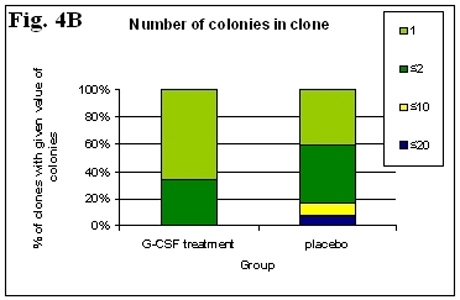
B. Proportion of clones, presented with different number of colonies.
Axis of abscissa: group
Axis of ordinate: proportion of clones with given number of colonies
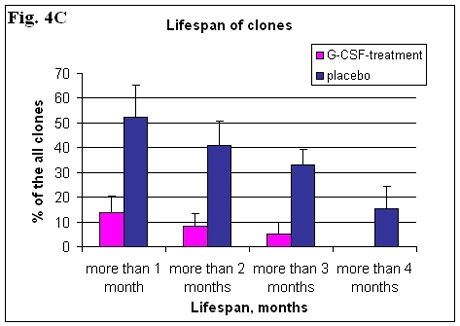
C. Life span of clones. Data are shown as the means (±SEM).
Axis of abscissa: life span of clones, months
Axis of ordinate: % of all clones
Acknowledgements
This study was supported by grants from the Russian Fund of Fundamental Investigation 07-04-00290-а and President of RF МК-3265.2007.4.
References
1. Dick JE, Magli MC, Huszar D, Phillips RA, and Bernstein A. Introduction of a selectable gene into primitive stem cells capable of long-term reconstitution of the hemopoietic system of W/Wv mice. Cell. 1985;42:71-79.
2. Drize NJ, Keller JR, and Chertkov JL. Local clonal analysis of the hematopoietic system shows that multiple small short-living clones maintain life-long hematopoiesis in reconstituted mice. Blood. 1996;88:2927-2938.
3. Kuramoto K, Follmann DA, Hematti P, Sellers S, Agricola BA, Metzger ME, Donahue RE, von Kalle C, and Dunbar CE. Effect of chronic cytokine therapy on clonal dynamics in nonhuman primates. Blood. 2004;103:4070-4077.
4. Abkowitz JL, Golinelli D, Harrison DE, and Guttorp P. In vivo kinetics of murine hemopoietic stem cells [In Process Citation]. Blood. 2000;96:3399-3405.
5. Drize NJ., Olshanskaya YV, Gerasimova LP, Manakova TE, Samoylina NL, Todria TV, and Chertkov JL. Lifelong hematopoiesis in both reconstituted and sublethally irradiated mice is provided by multiple sequentially recruited stem cells. Exp Hematol. 2001;29:786-794.
6. Morstyn G, Foote MA, Walker T, and Molineux G. Filgrastim (r-metHuG-CSF) in the 21st century: SD/01. Acta Haematol. 2001;105:151-155.
7. Molineux G, Pojda Z, Hampson IN, Lord, BI, and Dexter TM. Transplantation potential of peripheral blood stem cells induced by granulocyte colony-stimulating factor. Blood. 1990;76:2153-2158.
8. Till JEMEA. A direct measurement of radiation sencitivity of normal mouse bone marrow. Radiation Research. 1961;14:213-221.
9. Luskey BD, Rosenblatt M, Zsebo K, and Williams DA. Stem cell factor, interleukin-3, and interleukin-6 promote retroviral- mediated gene transfer into murine hematopoietic stem cells. Blood. 1992;80:396-402.
10. Maniatis T, Fritsch EF, and Sambrook J. Molecular Cloning, A Laboratory Manual. Cold Spring Harbor Laboratory). 1982.
11. Drize N, Chertkov J, Samoilina N, and Zander A. Effect of cytokine treatment (granulocyte colony-stimulating factor and stem cell factor) on hematopoiesis and the circulating pool of hematopoietic stem cells in mice. Exp Hematol. 1996;24:816-822.
12. Nifontova I, Svinareva D, Chertkov JL, Drize N, and Savchenko V. Late consequence of long-term treatment of mice with G-CSF. Bull Exp Biol Med. 2008;145:568-573.
13. Drize N, Chertkov J, Sadovnikova E, Tiessen S, and Zander A. Long-term maintenance of hematopoiesis in irradiated mice by retrovirally transduced peripheral blood stem cells. Blood. 1997;89:1811-1817.
14. Drize NI and Chertkov IL. Clone-Forming Activity of Embryonal Stem Hemopoietic Cells after Transplantation to Newborn or Adult Sublethally Irradiated Mice. Biull Eksp Biol. Med. 2000;130:110-112.
15. Metcalf D. Lineage commitment and maturation in hematopoietic cells: the case for extrinsic regulation. Blood. 1998;92:345-347.
16. Drize N, Gan O, and Zander A. Effect of recombinant human granulocyte colony-stimulating factor treatment of mice on spleen colony-forming unit number and self-renewal capacity. Exp Hematol. 1993;21:1289-1293.
17. Verfaillie CM. Hematopoietic stem cells for transplantation. Nat Immunol. 2002;3:314-317.
18. Korbling M, Anderlini P, and Hematology TA. Peripheral blood stem cell versus bone marrow allotransplantation: does the source of hematopoietic stem cells matter? Blood. 2001;98:2900-2908.
19. Uchida N, He D, Friera AM, Reitsma M, Sasaki D, Chen B, and Tsukamoto A. The unexpected G0/G1 cell cycle status of mobilized hematopoietic stem cells from peripheral blood. Blood. 1997;89:465-472.
20. Wright DE, Cheshier SH, Wagers AJ, Randall TD, Christensen JL, and Weissman IL. Cyclophosphamide/granulocyte colony-stimulating factor causes selective mobilization of bone marrow hematopoietic stem cells into the blood after M phase of the cell cycle. Blood. 2001;97:2278-2285.
Accepted 13 November 2008
Published 10 December 2008


